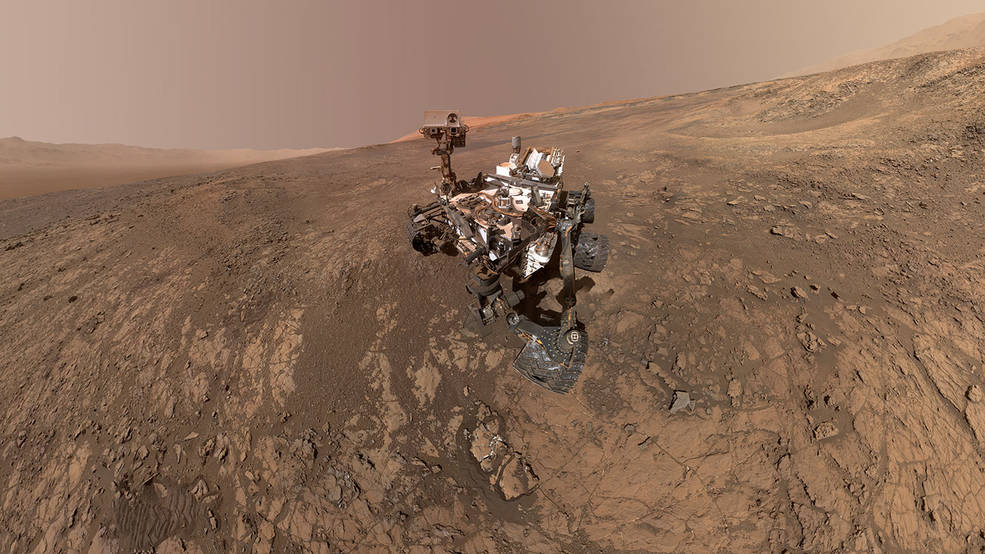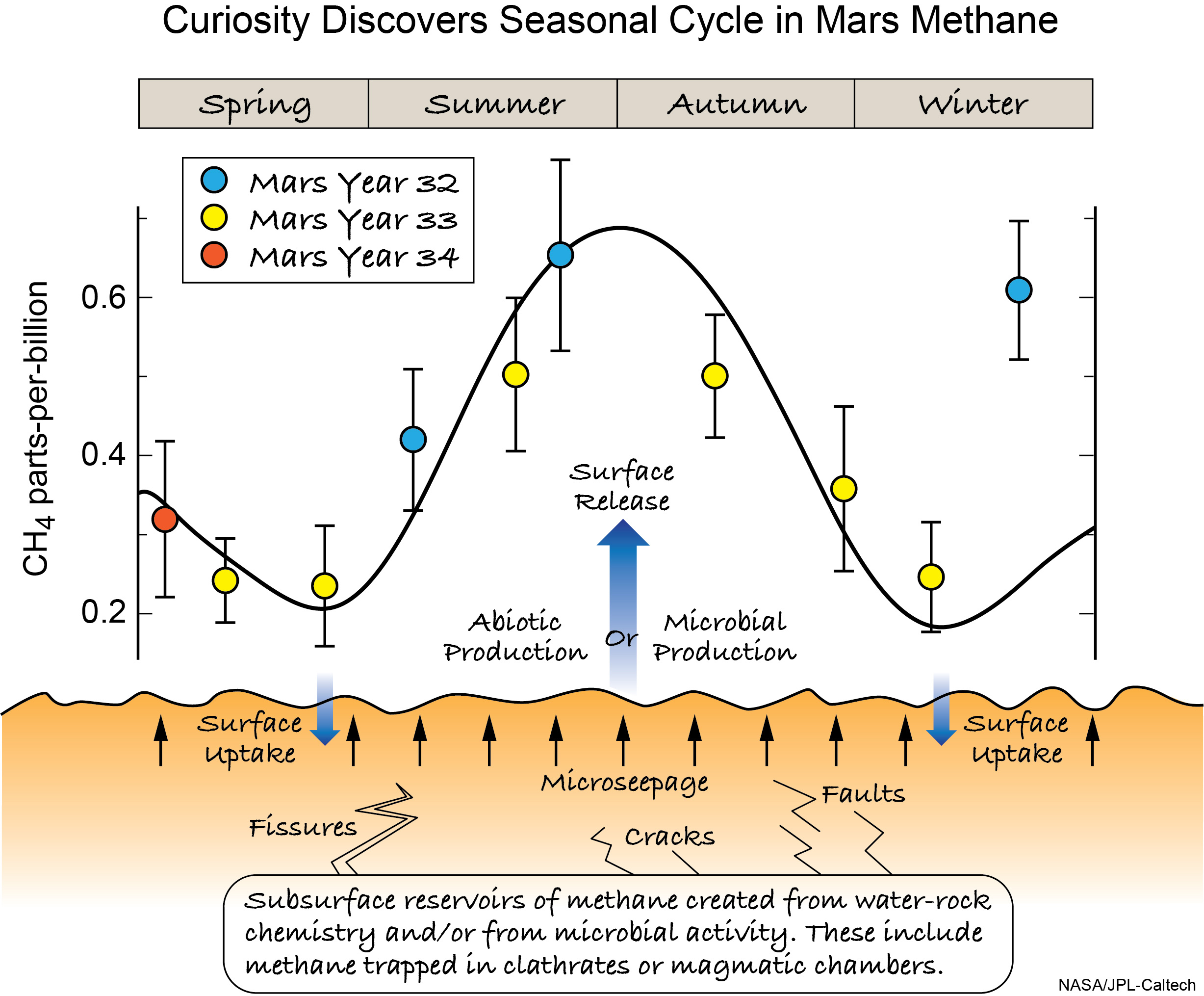Curiosity Rover Finds Ancient 'Building Blocks for Life' on Mars
If you're holding out hope that Mars may have once been an inhabited world, two new studies should put a little spring in your step.
NASA's Mars rover Curiosity has identified a variety of organic molecules, the carbon-based building blocks of life as we know it, in 3.5-billion-year-old Red Planet rocks, one of the papers reports.
"These results do not give us any evidence of life," stressed study lead author Jennifer Eigenbrode, a scientist at the Solar System Exploration Division at NASA's Goddard Space Flight Center in Greenbelt, Maryland. [The Search for Life on Mars: A Photo Timeline]
"But there is a possibility that [the organics] are from an ancient life source; we just don't know," Eigenbrode told Space.com. "And even if life was never around, they [the molecules] tell us there was at least something around for organisms to eat."

The other new paper also details a Curiosity find: that methane concentrations in Mars' atmosphere cycle seasonally. The discovery suggests that this gas, which here on Earth is produced primarily by living organisms, is seeping out from underground reservoirs, study team members said.
Again, these results are not evidence of life — methane can also be produced by geological processes — but they are consistent with the presence of Martian organisms, which is exciting in and of itself.
"We cannot rule out the possibility that it was created biologically," said study lead author Chris Webster, a senior research fellow at NASA's Jet Propulsion Laboratory (JPL) in Pasadena, California. "We can't say that it was, but we're certainly not dropping that idea. So, in a sense, that's positive for the astrobiologists in the world."
Get the Space.com Newsletter
Breaking space news, the latest updates on rocket launches, skywatching events and more!
Both new studies were published online today (June 7) in the journal Science.

The building blocks of life
The serious hunt for organics on Mars has a long and complicated history. It starts with NASA's twin Viking landers, which touched down on different parts of the Red Planet in 1976 to search for signs of life. The Vikings' science payload included an instrument called a gas chromatograph mass spectrometer (GCMS), which heated Martian soil and studied the molecules that boiled off.
While the Vikings' life-hunting experiments returned intriguing but ambiguous results, the GCMS found no organics. Indeed, the instrument spotted little of note, save for two chlorinated chemicals — chloromethane and dichloromethane — that were thought to be contaminants from Earth. This result convinced most scientists at the time that Mars is a dead planet; life as we know it is impossible without organic molecules, after all.
But that thinking began to shift a bit in 2008, when NASA's Phoenix lander found chlorine-containing chemicals called perchlorates in the Martian soil. Some researchers noted that perchlorates can destroy organics in a heated sample, and suggested that such reactions may have been responsible for the Vikings' null GCMS result.
In 2011, this hypothesis got some experimental backing. In a lab here on Earth, researchers heated perchlorate-spiked soil and spotted chloromethane and dichloromethane boiling out of the sample.
Then, Curiosity came onto the scene. The rover touched down inside Mars' huge Gale Crater in August 2012, kicking off a quest to determine if the Red Planet has ever been capable of supporting microbial life. Curiosity mission scientists quickly answered that question in the affirmative, finding that Gale hosted a long-lived, potentially habitable lake-and-stream system billions of years ago. [Photos: Ancient Mars Lake Could Have Supported Life]
The rover also found organics in relatively short order, using its Sample Analysis at Mars (SAM) instrument. SAM identified chlorinated hydrocarbons, such as chlorobenzene and dichlorobutane, in powdered samples drilled out of rock at a spot called Yellowknife Bay, which is near Curiosity's landing site.
The discovery confirmed the existence of native Martian organics. It was tough to know their full story, however, given the seeming ubiquity of perchlorates in the red dirt. For example, did these chlorinated compounds exist as-is in the rock, or were they created from other indigenous organics in a reaction inside SAM, which also heats its samples?
"We were a bit puzzled; we weren't sure what those molecules really meant in the bigger picture of the search for life," Eigenbrode said. "But it gave us a lot of anticipation that, if we can find these molecules here, perhaps we're going to come across other layers of rock that have more organics in them. And that's exactly what happened."
Climbing the mountain
In July 2013, Curiosity left the Yellowknife Bay area and started heading for Mount Sharp, the 3.4-mile-high (5.5 kilometers) mountain that rises from Gale's center. The six-wheeled robot made it to Mount Sharp's base 14 months later, then set to studying its environs.
In the new study, Eigenbrode and her colleagues looked closely at SAM's analyses of samples from the first two Mount Sharp rocks Curiosity drilled — powder collected from targets called Confidence Hills and Mojave in September 2014 and February 2015, respectively.
The researchers considered only the gases that boiled off at temperatures greater than 930 degrees Fahrenheit (500 degrees Celsius) — high enough to take possible perchlorate reactions out of the mix. They found several new organics, as well as a number of molecules that are probably fragments of much larger carbon-containing compounds.
The new observations increase the inventory of known Mars organics and "are more consistent with what we would expect if the organics were from life, from meteorites or from geological processes," Eigenbrode said.
SAM's measurements also suggest that the concentration of organic carbon in the drilled rocks is hundreds of parts per million, she added.
"When you get up to that level, now we're approaching the abundances of carbon that we find in rocks of similar age here on Earth," she said. "So the expectation is, if the stuff here on Earth was largely biological around 3 billion years ago, then there's a consistency there. But it doesn't really tell you anything specific. It's just, OK — it's not weird; it's not anomalous." [Ancient Mars Lakes & Laser Blasts: Curiosity Rover's 10 Biggest Moments in 1st 5 Years]
Methane mystery
Astrobiologists are also keen to better understand the distribution of methane in Mars' air, because the stuff is a potential "biosignature" gas. This is tough to do using Earth-based instruments, because there's a lot of methane in our planet's atmosphere — about 1,850 parts per billion (ppb) — to complicate matters.
So the new study led by Webster presents some landmark results. He and his colleagues report baseline atmospheric methane concentrations over about five Earth years, as measured by Curiosity's Tunable Laser Spectrometer (TLS) instrument. Gale Crater's levels are representative of the Red Planet as a whole, Webster said, given how much mixing goes on in Mars' air.
The researchers found that these concentrations ranged a great deal, from a low of about 0.24 ppb to a maximum of 0.65 ppb. And the variation is seasonal, with the peak coming near the end of the northern hemisphere's summer.
This strong seasonality rules out meteorites or infalling dust as the primary source, Webster said. He and his team instead think the methane is leaking continuously from underground reservoirs and then getting bound to soil particles when it reaches the surface. During warmer weather, more of the methane is freed from these particles and released into the air.
Methane gets destroyed by ultraviolet light within a few hundred years of the gas's appearance in Mars' atmosphere, so the stuff Curiosity detected must have been emitted relatively recently. But that doesn't mean those particular molecules formed recently, Webster said.
"These underground reservoirs — they can be made up of old methane, ancient methane, or they can be made up of modern, or new, methane that's being created today," he told Space.com. "We can't distinguish that."
Nor does the team know the methane's origin, Webster stressed. It could be produced by microbes, but geological processes — namely, the reaction of hot water with certain types of rock — are also a possibility. And the new study deals only with background levels of Mars methane; it doesn't offer any significant insight into one-off surges of the stuff, such as the spike to 7 ppb that Curiosity observed over a few weeks from late 2013 to early 2014.

Getting some answers
The Mars-methane picture could get clearer in the relatively near future. The Trace Gas Orbiter — part of the European-led ExoMars program — recently began sniffing the Red Planet's air from above, in an effort to map global concentrations of methane and other gases.
"The big question is, will they see plumes or patches or spikes?" Webster said. "If they could tell us there's a region of Mars where the methane seems to be coming from, that would be huge. Now we can direct future missions in that direction."
For example, the life-hunting ExoMars rover, which is scheduled to launch in 2020, could be sent to sample such a source. The rover might be able to get a carbon-isotope measurement, which would go a long way toward revealing the gas's origin. (Biologically produced methane here on Earth is depleted in the heavier carbon-13 isotope, which contains one more neutron in its nucleus than the "normal" carbon-12 atom.) Curiosity could theoretically make such a measurement as well, Webster said, but the ExoMars rover's TLS instrument will be more sensitive than Curiosity's.
Future missions will also take advantage of the new study by Eigenbrode and her team, Curiosity project scientist Ashwin Vasavada said.
"This gives us a really important insight into how organic molecules can be preserved over time, and what types might be better preserved than others," Vasavada, who's based at JPL, told Space.com. (Vasavada is a co-author of the new methane study but not the organics one.)
Curiosity's results show that lake beds are good collectors and concentrators of organics, he and Eigenbrode said. So an ancient lake wouldn't be a bad place to send a life-hunting rover, such as the ExoMars vehicle or the Mars 2020 rover, which NASA plans to launch two years from now.
"What this does, at the very least, is increase our confidence that there will be something to find with those future missions," Vasavada said, referring to interesting organics.
Follow Mike Wall on Twitter @michaeldwall and Google+. Follow us @Spacedotcom, Facebook or Google+. Originally published on Space.com.
Join our Space Forums to keep talking space on the latest missions, night sky and more! And if you have a news tip, correction or comment, let us know at: community@space.com.

Michael Wall is a Senior Space Writer with Space.com and joined the team in 2010. He primarily covers exoplanets, spaceflight and military space, but has been known to dabble in the space art beat. His book about the search for alien life, "Out There," was published on Nov. 13, 2018. Before becoming a science writer, Michael worked as a herpetologist and wildlife biologist. He has a Ph.D. in evolutionary biology from the University of Sydney, Australia, a bachelor's degree from the University of Arizona, and a graduate certificate in science writing from the University of California, Santa Cruz. To find out what his latest project is, you can follow Michael on Twitter.









